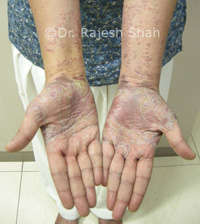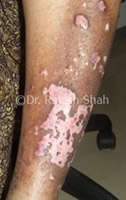Variants of Lichen Planus








Video on Lichen Planus
The most common areas affecting Lichen Planus are skin, mouth, scalp, and nails. There are several types of Lichen Planus, which might look similar by they have varying characteristics and prognosis. Some varieties of Lichen Planus are easier treated than others. Y
Lichen Planus Hypertrophicus: It looks like a keloid or hypertrophied scar, often found on the ankles.
Lichen Planus Actinus:
Lichen Nitidus: Observed along with regular eruptions of LP, more on the light-exposed body parts.
Lichen Sclerosus et Atrophics: A rare condition affecting the vulva, male genitals. With tremendous itching, there is atrophy and scarring of the affected organ.
Lichen Planus Linearis: More closely aggregated eruptions, extending along the entire limb, seen in children.
Lichen Planus Annularis: Often affecting the genitals and scrotum.
Lichen Planus Follicularis (Lichen Planopilaris): Observed in the hair-bearing areas such as the scalp, pubic region.
Lichen Planus Atrophicus:
Bullous Lichen Planus: Bullous eruption and vesicles.
Lichen Planus Pigmentosa: As the name suggests, there is a kind of hyperpigmentation that is grayish in color. Seen more in females in western countries. (Click for more details.)

Normal, any part of the body may get affected. However, it has a tendency to involve the skin of the lower limbs, legs, and the mucous membrane of the mouth. The flexors of the legs, inner thighs, the front of the wrists, and skin on the lower back are affected in many cases.
It has an affinity for the genitals involved. In males, the glans, while in females, the vagina and vulva may be affected.
One of the uncommon areas of affliction with Lichen Planus is eyelids, which is reported in a case treated at Life Force:

The nails, when affected, tend to become deformed. In short, Lichen Planus affecting the skin, mouth (Oral Lichen Planus), and vaginal LP are some of the most common variants. When the oral mucosa or the genitals are affected, this condition is often neglected, reported late, or incorrectly diagnosed.
 This is a photo of a rare case where the patient has lichen planus and psoriasis concurrently.
This is a photo of a rare case where the patient has lichen planus and psoriasis concurrently.
This 27-year-old female was suffering from lichen planus for six months. She recently developed psoriasis in her palms. This is an uncommon presentation. At Life Force, we have documented many such common and uncommon variants of Lichen Planus.
Similarly, there may be a combination of Lichen Planus with Eczema, Urticaria, and Prurigo nodularis.
Essentially all chronic skin diseases are due to immunological reasons. Such immunological causes may have a genetic background, making one prone to developing such diseases.
 In this case, you will find Lichen Planus associated with and leading to vitiligo. Such a presentation is not very common. Lichen Planus and vitiligo both are autoimmune diseases. Sometimes, due to chronic inflammation in Lichen Planus, one may lose pigments on the underlying layers, learning to vitiligo. This type of vitiligo is difficult to treat.
In this case, you will find Lichen Planus associated with and leading to vitiligo. Such a presentation is not very common. Lichen Planus and vitiligo both are autoimmune diseases. Sometimes, due to chronic inflammation in Lichen Planus, one may lose pigments on the underlying layers, learning to vitiligo. This type of vitiligo is difficult to treat.

Written & Approved by-
Dr. Rajesh Shah
M.D. (Hom.)